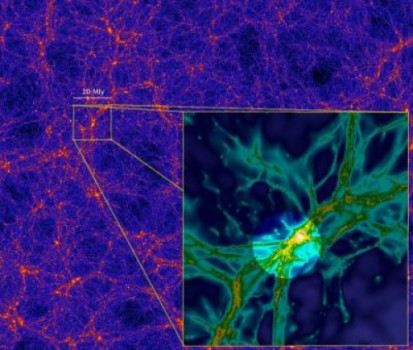|
The Well Balanced Universe |
|||
Astronomy newsDistant quasar shows up gross error in standard cosmological model20 January 2013
Astronomers have discovered a distant quasar illuminating a vast nebula
of diffuse gas, containing far more normal matter than predicted by the
current cosmological model. Researchers at the University of California
led the study, published in Nature. "This is a very exceptional object: it's huge, at least twice as large as any nebula detected before, and it extends well beyond the galactic environment of the quasar," said first author Sebastiano Cantalupo. The standard cosmological model of structure formation in the universe predicts that galaxies are embedded in a cosmic web of matter, most of which (about 84 percent) is invisible dark matter. This web is seen in computer simulations of the evolution of the universe. These simulated maps show the predicted distribution of dark matter on large scales, including the dark matter halos in which galaxies are supposed to form, and the cosmic web of filaments that would connect them. It is thought that gravity would cause ordinary matter to follow the distribution of dark matter; so filaments of diffuse, ionized gas are expected to trace a pattern similar to that seen in the dark matter simulations. Until now, however, these filaments have never been seen. Intergalactic gas has been detected by its absorption of light from bright background sources, but those results don't reveal how the gas is distributed. In this study, the researchers detected the fluorescent glow of hydrogen gas resulting from its illumination by intense radiation from the quasar.
"This quasar is illuminating diffuse gas on scales well beyond any we've seen before, giving us the first picture of extended gas between galaxies. It provides a terrific insight into the overall structure of our universe," said co-author J. Xavier Prochaska. The researchers estimated the amount of gas in the nebula to be at least ten times more than expected from the results of computer simulations. "These observations are challenging our understanding," Cantalupo said. |
|
||
More news ...
|
|||
